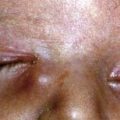Chapter 167 Child Care and Communicable Diseases
Although the majority of children who attend child-care facilities are cared for in child-care home settings, most studies of infectious diseases among children in out-of-home child care have been conducted among infants (birth to 12 mo of age) and toddlers (13-36 mo of age) who are enrolled in a child-care center. Almost any organism has the potential to be spread and to cause disease in a child-care setting. Epidemiologic studies have established that children in child-care facilities are 2-18 times more likely to acquire a variety of infectious diseases than are children not enrolled in child care (Table 167-1). Children in child-care facilities are more likely both to receive more courses of antimicrobial agents for longer periods and to acquire antibiotic-resistant organisms. Transmission of infectious agents in group care depends on the age and immune status of the children, season, hygiene practices, crowding, environmental characteristics of the facilities, and characteristics of the pathogen, including its infectivity, survivability in the environment, and virulence. Rates of infection, duration of illness, and risk for hospitalization tend to decrease among children in child-care facilities after the 1st 6 mo of attendance and decline to levels observed among home-bound children after 3 yr of age. In general, children starting out-of-home care at 2 yr of age handle respiratory tract infections and their complications better than children starting at 6 mo of age. Adult caregivers are also at increased risk for acquiring and transmitting infectious diseases, particularly in the 1st year of contact with children in these settings.
Table 167-1 INFECTIOUS DISEASES IN THE CHILD-CARE SETTING
| DISEASE | INCREASED INCIDENCE WITH CHILD CARE |
|---|---|
| RESPIRATORY TRACT INFECTIONS | |
| Otitis media | Yes |
| Sinusitis | Probably |
| Pharyngitis | Probably |
| Pneumonia | Yes |
| GASTROINTESTINAL TRACT INFECTIONS | |
| Diarrhea (rotavirus, calicivirus, astrovirus, enteric adenovirus, Giardia lamblia, Cryptosporidium, Shigella, Escherichia coli O157:H7, and Clostridium difficile) | Yes |
| Hepatitis A | Yes |
| SKIN DISEASES | |
| Impetigo | Probably |
| Scabies | Probably |
| Pediculosis | Probably |
| Tinea (ringworm) | Probably |
| INVASIVE BACTERIA INFECTIONS | |
| Haemophilus influenzae type b | No* |
| Neisseria meningitidis | Probably |
| Streptococcus pneumoniae | Yes |
| ASEPTIC MENINGITIS | |
| Enteroviruses | Probably |
| HERPESVIRUS INFECTIONS | |
| Cytomegalovirus | Yes |
| Varicella-zoster virus | Yes |
| Herpes simplex virus | Probably |
| BLOOD-BORNE INFECTIONS | |
| Hepatitis B | Few case reports |
| HIV | No cases reported |
| Hepatitis C | No cases reported |
| VACCINE-PREVENTABLE DISEASES | |
| Measles, mumps, rubella, diphtheria, pertussis, tetanus | Not established |
| Polio | No |
| H. influenzae type b | No* |
| Varicella | Yes |
| Rotavirus | Yes |
* Not in the postvaccine era; yes in the prevaccine era.
Skin Diseases
The most commonly recognized skin infections or infestations in children in child care are impetigo caused by Staphylococcus aureus or group A streptococcus, pediculosis, scabies, tinea capitis, and tinea corporis. Many of these diseases are spread by contact with infected linens, clothing, hairbrushes, and hats and through direct personal contact; they more often affect children >2 yr of age. The magnitude of these infections and infestations in children in child care is not known. Parvovirus B19, which causes fifth disease (erythema infectiosum), is spread through the respiratory route, and outbreaks have occurred in child-care centers. The rash of fifth disease is a systemic manifestation of parvovirus B19 infection; the child is no longer contagious once the rash is present (Chapter 243). The greatest health hazard is for pregnant women and immunocompromised hosts owing to their respective risks for fetal loss and aplastic crisis.
Herpesviruses
Studies of CMV infection in child-care centers have shown that as many as 70% of diapered children continuously shed CMV in urine and saliva after they become infected. CMV-infected children often transmit the virus to other children with whom they have contact, as well as to their care providers and their mothers at a rate of 8-20% per year. Transmission occurs as a result of contact with either saliva or urine. The overwhelming majority of primary infection with and reactivation of CMV in otherwise healthy children results in asymptomatic shedding of CMV virus; nonetheless, this shedding can pose a health risk for previously uninfected pregnant child-care providers or immunocompromised persons (Chapter 247). Varicella often is transmitted in child-care centers, but routine use of varicella vaccine has reduced this risk. Vaccinated children who become infected with varicella often have mild, atypical symptoms and signs of disease that can result in delayed recognition and spread of infection to susceptible contacts. The role of child-care facilities in the spread of herpes simplex virus, especially during episodes of gingivostomatitis, requires further clarification.
Prevention
Written policies designed to prevent or to control the spread of infectious agents in a child-care center should be available and should be reviewed regularly. It is suggested that all programs use a health consultant to help with development and implementation of infection-control policies. Standards for environmental and personal hygiene should include maintenance of current immunization records for both children and staff, appropriate policies for exclusion of ill children and caretakers, targeting of potentially contaminated areas for frequent cleaning, adherence to appropriate procedures for changing diapers, appropriate handling of food, management of pets, and surveillance for and reporting of communicable diseases. Staff whose primary function is preparing food should not change diapers. Strategies for improving adherence to these standards should be implemented. Appropriate and thorough hand hygiene is the most important factor for reducing infectious diseases in the child-care setting. Children at risk for introducing an infectious disease should not attend child care until they are no longer contagious (Tables 167-2 and 167-3).
Table 167-2 DISEASE- OR CONDITION-SPECIFIC RECOMMENDATIONS FOR EXCLUSION OF CHILDREN IN OUT-OF-HOME CHILD CARE
| CONDITION | MANAGEMENT OF CASE | MANAGEMENT OF CONTACTS |
|---|---|---|
| Hepatitis A virus (HAV) infection | Serologic testing to confirm HAV infection in suspected cases Exclusion until 1 week after onset of jaundice |
If ≥1 case is confirmed in child or staff attendees or ≥2 cases in households of staff or attendees, HAV vaccine or IG should be administered within 14 days of exposure to unimmunized staff and attendees In centers without diapered children, HAV vaccine or IG should be given to unimmunized classroom contacts of index case Asymptomatic IG recipients may return after receipt of IG |
| Impetigo | Exclusion until 24 hr after treatment has been initiated Lesions on exposed skin covered with watertight dressing |
No intervention needed unless additional lesions develop |
| Measles | Exclusion until 4 days after beginning of rash and when the child is able to participate | Immunize exposed children without evidence of immunity within 72 hr of exposure Children who do not receive vaccine within 72 hr or who remain unimmunized after exposure should be excluded until at least 2 wk after onset of rash in the last case of measles |
| Mumps | Exclusion until 5 days after onset of parotid gland swelling | In outbreak setting, people without documentation of immunity should be immunized or excluded Immediate readmission may occur following immunization Unimmunized people should be excluded for ≥26 days following onset of parotitis in last case |
| Pediculosis capitis (head lice) | Treatment at end of program day and readmission on completion of first treatment | Household and close contacts should be examined and treated if infested No exclusion is necessary |
| Pertussis | Exclusion until 5 days of appropriate antimicrobial therapy course have been completed | Immunization and chemoprophylaxis should be administered as recommended for household contacts Symptomatic children and staff should be excluded until completion of 5 days of antimicrobial therapy course Untreated adults should be excluded until 21 days after onset of cough |
| Rubella | Exclusion until 6 days after onset of rash for postnatal infection | Pregnant contacts should be evaluated |
| Salmonella serotype Typhi infection | Exclusion until diarrhea resolves 3 negative stool culture results required before readmission |
Stool cultures should be performed for attendees and staff; infected people should be excluded on the basis of age |
| Non–serotype Typhi Salmonella infection | Exclusion until diarrhea resolves. Negative stool culture results not required for non–serotype Typhi Salmonella species. | Symptomatic contacts should be excluded until symptoms resolve Stool cultures are not required for asymptomatic contacts Antimicrobial therapy is not recommended for asymptomatic infection or uncomplicated diarrhea or for contacts |
| Scabies | Exclusion until after treatment given | Close contacts with prolonged skin-to-skin contact should have prophylactic therapy Bedding and clothing in contact with skin of infected people should be laundered |
| Shiga toxin–producing Escherichia coli (STEC), including E. coli O157:H7, or Shigella infection | Exclusion until diarrhea resolves and results of 2 stool cultures are negative for these organisms, depending on state regulations | Meticulous hand hygiene; stool cultures should be performed for contacts Center(s) with cases should be closed to new admissions during E. coli O157:H7 outbreak |
| Staphylococcus aureus skin infections | Exclusion only if skin lesions are draining and cannot be covered with a watertight dressing | Meticulous hand hygiene Cultures of contacts are not recommended |
| Streptococcal pharyngitis | Exclusion until 24 hours after treatment has been initiated and the child is able to participate in activities | Symptomatic contacts of documented cases of group A streptococcal infection should be tested and treated if test results are positive |
| Tuberculosis | For active disease, exclusion until determined to be noninfectious by physician or health department authority May return to activities after therapy is instituted, symptoms have diminished, and adherence to therapy is documented No exclusion for latent tuberculosis infection |
Local health department personnel should be informed for contact investigation |
| Varicella | Exclusion until all lesions have dried and crusted, usually 6 days after onset of rash in immunocompetent people; may be longer in immunocompromised people | Varicella vaccine should be administered by 3-5 days after exposure, and varicella-zoster IG should be administered up to 96 hr after exposure when indicated |
HAV, hepatitis A vaccine; IG, immunoglobulin.
From Pickering LK, Baker CJ, Kimberlin DW, et al, editors: Red book: 2009 report of the Committee on Infectious Diseases, ed 28, Elk Grove Village, IL, 2009, American Academy of Pediatrics, p 129.
Table 167-3 GENERAL RECOMMENDATIONS FOR EXCLUSION OF CHILDREN IN OUT-OF-HOME CHILD CARE
| SYMPTOM(S) | MANAGEMENT |
|---|---|
| Illness preventing participation in activities, as determined by child care staff | Exclusion until illness resolves and able to participate in activities |
| Illness that requires care greater than staff can provide without compromising health and safety of others | Exclusion or placement in care environment where appropriate care can be provided without compromising care of others |
| Severe illness suggested by fever with behavior changes, lethargy, irritability, persistent crying, difficulty breathing, progressive rash | Medical evaluation and exclusion until symptoms have resolved |
| Rash with fever or behavioral change | Medical evaluation and exclusion until illness is determined not to be communicable |
| Persistent abdominal pain (≥2 hr) or intermittent abdominal pain associated with fever, dehydration, or other systemic signs and symptoms | Medical evaluation and exclusion until symptoms have resolved |
| Vomiting ≥2 times in preceding 24 hr | Exclusion until symptoms have resolved, unless vomiting is determined to be caused by a noncommunicable condition and child is able to remain hydrated and participate in activities |
| Diarrhea or stools containing blood or mucus | Medical evaluation and exclusion until symptoms have resolved |
| Oral lesions | Exclusion until child or staff member is considered to be noninfectious (lesions crusted and dry) |
From Pickering LK, Baker CJ, Kimberlin DW, et al, editors: Red book: 2009 report of the Committee on Infectious Diseases, ed 28, Elk Grove Village, IL, 2009, American Academy of Pediatrics, p 128.
Alder SP, Finney JW, Manganello AM, et al. Prevention of child-to-mother transmission of cytomegalovirus among pregnant women. J Pediatr. 2004;145:485-491.
American Academy of Pediatrics and the American Public Health Association. Caring for our children: national health and safety performance standards: guidelines for out-of-home child care, ed 2. Elk Grove Village, IL: American Academy of Pediatrics; 2002.
. Managing infectious diseases in child care and schools. Aronson SS, Shope TR, . American Academy of Pediatrics, Elk Grove Village, IL, 2005.
Bradley RH. Child care and common communicable illnesses in children aged 37 to 54 months. Arch Pediatr Adolesc Med. 2003;157:196-200.
Centers for Disease Control and Prevention. Prevention and control of influenza—recommendations of the Advisory Committee on Immunization Practices (ADIP). MMWR Recomm Rep. 2007;56(RR-06):1-54.
Churchill RB, Pickering LK. Infection control challenges in child care centers. Infect Dis Clin North Am. 1997;11:347-385.
Dagan R, Sikuler-Cohen M, Zamir O, et al. Effect of a conjugate pneumococcal vaccine on the occurrence of respiratory infections and antibiotic use in day-care center attendees. Pediatr Infect Dis J. 2001;20:951-958.
Dayan GH, Quinlisk P, Parker AA, et al. Recent resurgence of mumps in the United State. N Engl J Med. 2008;15:1580-1589.
Givo-Lavi N, Fraser D, Dagan R. Vaccination of day-care center attendees reduces carriage of Streptococcus pneumoniae among their younger siblings. Pediatr Infect Dis J. 2003;22:524-532.
Hurwitz ES, Haber M, Chang A, et al. Effectiveness of influenza vaccination of day care children in reducing influenza-related morbidity among household contacts. JAMA. 2000;284:1677-1682.
National Institute of Child Health and Human Development Early Childcare Research Network. Childcare and common communicable illnesses. Results from the National Institute of Child Health and Human Development Study of Early Child Care. Arch Pediatr Adolesc Med. 2001;155:481-488.
Pass RF. Day care centers and the spread of cytomegalovirus and parvovirus B19. Pediatr Ann. 1991;20:419-426.
Pickering LK, Baker CJ, Kimberlin DW, et al, editors. Red book: 2009 report of the Committee on Infectious Diseases, ed 28, Elk Grove Village, IL: American Academy of Pediatrics, 2009.
Richardson M, Elliman D, Maguire H, et al. Evidence base of incubation periods, periods of infectiousness and exclusion policies for the control of communicable disease in schools and preschools. Pediatr Infect Dis J. 2001;20:380-391.
Roberts L, Smith W, Jorm L, et al. Effect of infection control measures on the frequency of upper respiratory infection in childcare: A randomized, controlled trial. Pediatrics. 2000;105:738-742.
Rossi GA, Medici MC, Arcangeletti MC, et al. Risk factors for severe RSV-induced lower respiratory tract infection over four consecutive epidemics. Eur J Pediatr. 2007;166:1267-1272.
Thrane N, Olesen C, Mortensen JT, et al. Influence of day care attendance on the use of systemic antibiotics in 0- to 2-year-old children. Pediatrics. 2001;107:E76.
U.S. Census Bureau. School enrollment (website). www.census.gov/population/www/socdemo/school.html. Accessed August 2, 2010
Vesikari T, Matson DO, Dennehy P, et al. Safety and efficacy of pentavalent human-bovine reassortant rotavirus vaccine. N Engl J Med. 2006;354:23-33.






